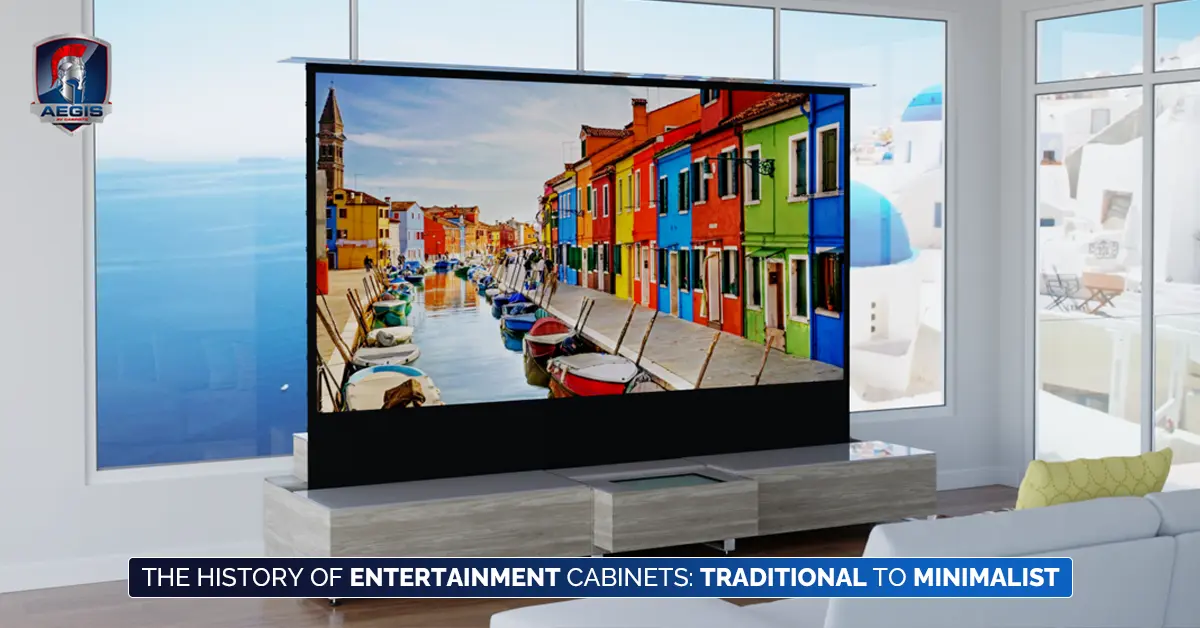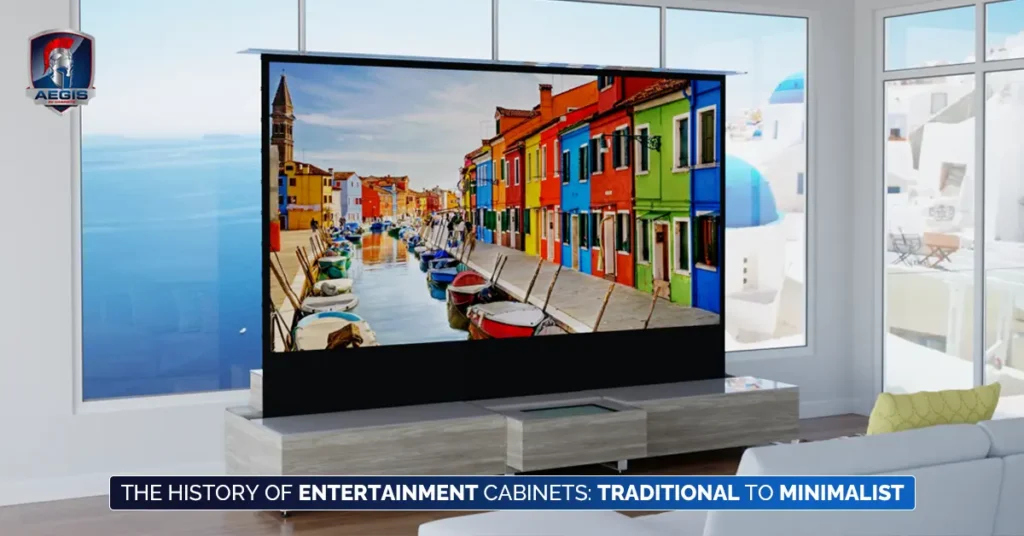
The entertainment cabinet has come a long way. It once stood heavy and proud, crafted for radios and bulky TVs. Now, it is big and bold, built to dominate the room.
Today, it’s a different story. Sleek lines have replaced ornate curves. Heavy wood has given way to light floating shelves. What was once a box for tech is now a symbol of style.
This transformation tells more than a design story. It reflects how we live, relax, and connect. It mirrors changing tastes, advancing tech, and our love for simplicity. From grand traditions to minimalist visions, the cabinet has kept pace.
- Planning a new space?
- Updating your living room?
- Designing the media wall of your dreams?
Knowing this guide to evolution helps. It guides smarter choices, sparks fresh ideas, and lets you create a space that feels both beautiful and intentional.
A Brief History of Entertainment Cabinets
The entertainment cabinet tells a story, not just of design but of us—how we lived, what we loved, how we gathered around sound, then screens. It shaped itself around what mattered, and in every era, it adapted.
The Birth of a Classic (1920s–1940s)
It all began with the radio. In the ’20s and ’30s, sound was king. Families circled large wooden consoles, tuning in. Oak, walnut, and mahogany filled the room. These weren’t just radios—they were furniture. Proud, ornate, built to be seen, they stood tall in formal rooms, a centerpiece of music and news.
Then came television. By the late ’40s, screens arrived. Cabinets evolved, adding space for TV, but elegance remained. Sliding doors hid the screens inside. Style still mattered—function never stood alone.
The Golden Age of TV Consoles (1950s–1970s)
Television took over. By the ’50s, it ruled the home. And cabinets followed suit. Wider. Lower. Heavier. They held everything—TVs, records, radios. Some even hid turntables and tapes. These weren’t just cabinets. They were the living room anchor.
One piece. One purpose. Bringing families together, night after night. Bold frames. Built-ins. Wall to wall. They said, This is where we gather.
Modular and Mass-Market (1980s–1990s)
Then came the ’80s and ’90s. Tech changed, and so did furniture. Big screens, VCRs, game consoles, and cables were everywhere.
Cabinets became modular. Built for function, not finesse. MDF replaced solid wood.
Shelves adjusted. Panels had cable slots.
- Useful? Yes.
- Beautiful? Not quite.
These units were built for the moment, not for the next generation. Still, they served their time, holding the weight of modern life.
The Rise of the Minimalist Entertainment Center
A shift happened—subtle, but powerful. As homes grew brighter and cleaner, furniture followed the same path. Gone were the bulky frames. Smooth surfaces and calm lines came in.
The cabinet became something else—sleek, low, almost invisible. It didn’t scream for attention. It whispered style, simplicity, and space—function wrapped in elegance—a centrepiece without the clutter.
Enter the Flat Screen (2000s–2010s)
The flat screen changed everything. There was no more depth, no more weight. TVs were slim, sharp, and modern. Design followed fast. Cabinets lost their bulk overnight. In their place came clarity, clean silhouettes, and floating forms. Some even disappeared into walls.
These pieces embraced space. Negative space. Breathing room. They hid what didn’t belong. Drawers closed softly. Remotes, wires, devices—out of sight. It wasn’t just new furniture. It was a new mindset.
Space-Saving Innovation
Cities got tighter. Rooms got smaller. But style didn’t have to shrink. Designers got smart with this space-saving entertainment unit cabinets floated. Corners got used. One unit, many roles. Less space, more purpose.
Floating consoles created a lift. They opened the floors and widened the walls. Even small spaces felt spacious. Perfect for lofts, studios, and open plans. Minimalist, but never dull. Every piece earned its place. Every detail served a need.
The result? Living rooms that breathe. Homes that feel lighter. Cabinets that fit life beautifully.
The Rise of Customization and Smart Functionality
Entertainment has changed, and so have the cabinets we trust to hold it. Today, function meets intelligence. And beauty? It’s still right at the center. Furniture doesn’t just sit anymore. It adapts, reacts, and thinks. This Smart TV Cabinet features advanced day by day.
Technology Meets Design
Innovative features now come built in. And they’re more than surface-deep.
- Cable clutter? Managed.
- Electronics? Kept cool.
- Lighting? Soft and seamless.
Soundbars have a home. Projectors too. And yes—even hidden TVs. Motorized lifts rise on command. Drawers charge your phone wirelessly. Cabinets now sync with your smart home. This isn’t just storage. It’s living room tech, reimagined.
Custom Entertainment Cabinets: Function Meets Form
Every home has its own rhythm, and now, your furniture can match it. Custom cabinets bring that freedom. You choose the shape, the shade, and the soul.
- Need more storage?
- Want a cleaner look?
- Have an awkward corner to fill? No problem.
From city lofts to rustic dens— your cabinet fits your space, your way. Finishes. Features. Fixtures. All tailored by you. And the materials? That’s a story in itself. Let’s dive into that next.
A Deep Dive into Entertainment Cabinet Materials
What it’s made of matters—not just for strength but for the soul it brings to your room. Each material tells a story, and each finish sets a mood. Let’s explore the ones that truly stand out.
Solid Wood
Timeless, warm, and rich with depth, solid wood makes a statement. Think oak, walnut, and cherry—grains that grow more beautiful with time. This is heirloom quality, built to last, built to be loved. It’s not just a cabinet—it’s a legacy in wood.
Engineered Wood (MDF, Plywood)
Smart, flexible, and budget-friendly, Engineered wood is a good choice for modern homes. Lighter than solid wood, it is still strong enough to support your gear. Finished with laminates, paint, or real veneer, it gives you the look you want at the price you need. It is perfect for sleek, modern designs.
Glass and Metal
Minimal, bold, and clean lines only. Glass and metal feel modern and sharp. Clear shelves. Steel frames. This setup lets your tech shine. It’s light in look but heavy on style. Just one note—they offer less hidden storage.
Eco-Friendly & Sustainable Materials
Design with a conscience. That’s where these materials shine: bamboo, recycled wood, and reclaimed metals. Each one is eco-smart and packed with character, for those who care about the planet, and their space—style and sustainability are in perfect balance.
Entertainment Cabinet Styles: Match Design with Your Life
Your cabinet should fit your space. But more than that— It should fit how you live. Let’s find your perfect match.
Vintage & Traditional
Elegant, bold, and full of detail, this piece features carved wood and warm tones. This Vintage Entertainment Cabinet commands attention and is ideal for classic homes and formal living rooms.
Modern TV Stand Designs
Sleek. Smart. Understated. Clean lines and soft lighting. Storage stays hidden. Your space stays serene.
Minimalist Entertainment Center
Less is more. Always. Handleless drawers. Floating shelves. Soft matte finishes. It works in Scandi spaces, or city apartments.
Industrial or Urban Loft
Raw, edgy, and built to stand out, it features metal frames and worn wood. It feels unfinished—on purpose. Perfect for open lofts or creative studios.
Tech-Integrated Smart Cabinets
For the modern media lover, think motorized lifts, LED accents, built-in charging, and Bluetooth speakers. Innovative features meet smart design.
Why a Quality Entertainment Cabinet Still Matters Today
We stream everything now—no wires, no discs. So why do cabinets still count? Good design isn’t digital.
Your cabinet grounds the space.,hides clutter.,holds your essentials, and defines your zone in open-plan homes,
It’s not just furniture—it’s part of the experience. Relax, watch, gather, and do it all with style.
Looking for the Perfect Entertainment Cabinet?
At Aegis AV, we don’t make furniture. We craft experiences. Every cabinet is a centerpiece. It is built with precision, designed with heart, and made right here in the USA—with materials that last and innovation that leads.
- Need a smart setup?
- Want sleek, hidden tech?
- Crave clean lines and full customization? We’ve got you covered.
From our patented UST Comerptement designs to full A–Z customization, we bring your vision to life. Whether you want modern minimalism or space-saving magic for your small home, we make it happen.
FAQs
How To Hide Cables In Entertainment Cabinets?
No one likes a mess, so pick cabinets with rear openings, trays, or grommets. These features route your wires beyond view. Want something more seamless? Go for wall conduits or cable sleeves. Go for versions with removable back panels for effortless maintenance. Less chaos. More calm.
What Size TV Fits My Entertainment Unit?
Start with the TV’s width, edge to edge. Now check your cabinet’s surface or interior space. Your cabinet has to be 20–30% larger, which helps with balance and breathing space. Also, check the weight limit and make sure with airflow because nobody likes heated electronics.
Are Floating TV Cabinets Safe And Strong?
Yes, as long as they are installed correctly. They must anchor to studs or solid masonry. Use strong, level brackets rated for your gear. Modern floating units are built for tech. They free up floor space and look wonderfully tidy.
Can I Use An Entertainment Cabinet In A Bedroom?
Definitely not; entertainment cabinets only exist in the living room. They store televisions, books, and clothing in the bedroom, even for decoration. For small rooms, select a compact and low-profile model. Or one that blends a dresser with tech storage. Style blended with function, all in one form.
Do Entertainment Cabinets Affect Sound Quality?
They can—yes. A soundbar’s closed doors can muffle sound, but open shelves let sound breathe. To achieve both, set aside mesh fronts or speaker-compatible cutouts. Besides, keep speakers clear of corners or wall backs. Let your sound perform at the best of its ability.
Final Thoughts: Where Style Meets the Future
The entertainment cabinet has advanced from box TVs and radios to functioning as a modern home’s central console.
- It’s no longer just storage.
- It’s design. It’s tech.
- It’s how we live.
The future is seamless and beautiful, effortless, modular, intelligent, tailored, eco-friendly materials, personalized sustainable structures, and centered around the user.

